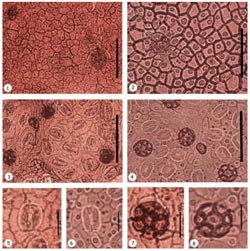Researchers found response of how plants respond to the changing environment in geological time

1, 3, 5, 7: This is the micro-morphology of fossil Quercus delavayi complex. 2, 4, 6, 8 Micro-morphology of extant Q. delavayi.<br><br>Credit: ©Science China Press<br>
As the only direct evidence of past life, fossils provide important information on the interactions between plants and environmental change. After ten years' survey, Professor Zhou Zhekun's group from Kunming Institute of Botany has discovered more than ten well preserved Neogene plant fossil sites in southwestern China which are important to understand past climate and response of plants to the changing climate in this region.
Their recent work, entitled “Evolution of stomatal and trichome density of the Quercus delavayi complex since the late Miocene”, was published in CHINESE SCIENCE BULLETIN.2013, Vol 58(21).
Comparing closely related fossils from different geological periods is an efficient method to understand how plants respond to climatic change across a large scale. However, few studies have been carried out due to lack of a continuous fossil record. In their recent study, Prof. Zhou's group investigated detailed micro-morphology of a dominant element in Neogene fossil sites, Quercus delavayi complex (one oak species) to answer this question.
Their results show that Quercus delavayi complex from different periods share similar leaf morphology, but differ with respect to trichome and stomatal densities. The stomatal density of the Q. delavayi complex was the highest during the late Miocene, declined in the late Pliocene, and then increased during the present epoch. These values show an inverse relationship with atmospheric CO2 concentrations. Since the late Miocene, a gradual reduction in trichome base density has occurred in this complex. This trend is the opposite of that of precipitation, indicating that increased trichome density is not an adaptation to dry environments. These results are important to understand the relationship between plant evolution and climatic change which are important to predict the fate of current biodiversity in a changing environment.
This research project was partially supported by a grant from the National Natural Science Foundation of China and a 973 grant from Department of Science and Technology of China. Knowledge of the past is crucial to understand the future. The researchers suggest the old subject 'Paleontology' can reveal long term evolution in the past which is hardly seen in 'Neontology' should receive more attention.
See the article: Hu Q, Xing Y W, Hu J J, Huang Y J, Ma H J, Zhou Z K. Evolution of stomatal and trichome density of the Quercus delavayi complex since the late Miocene. Chin Sci Bull, 2013, 58, doi: 10.1007/s11434-013-6005-x
http://csb.scichina.com:8080/kxtb/CN/abstract/abstract511896.shtml
Science China Press Co., Ltd. (SCP) is a scientific journal publishing company of the Chinese Academy of Sciences (CAS). For 50 years, SCP takes its mission to present to the world the best achievements by Chinese scientists on various fields of natural sciences researches.
Media Contact
More Information:
http://www.scichina.orgAll latest news from the category: Life Sciences and Chemistry
Articles and reports from the Life Sciences and chemistry area deal with applied and basic research into modern biology, chemistry and human medicine.
Valuable information can be found on a range of life sciences fields including bacteriology, biochemistry, bionics, bioinformatics, biophysics, biotechnology, genetics, geobotany, human biology, marine biology, microbiology, molecular biology, cellular biology, zoology, bioinorganic chemistry, microchemistry and environmental chemistry.
Newest articles

Bringing bio-inspired robots to life
Nebraska researcher Eric Markvicka gets NSF CAREER Award to pursue manufacture of novel materials for soft robotics and stretchable electronics. Engineers are increasingly eager to develop robots that mimic the…

Bella moths use poison to attract mates
Scientists are closer to finding out how. Pyrrolizidine alkaloids are as bitter and toxic as they are hard to pronounce. They’re produced by several different types of plants and are…

AI tool creates ‘synthetic’ images of cells
…for enhanced microscopy analysis. Observing individual cells through microscopes can reveal a range of important cell biological phenomena that frequently play a role in human diseases, but the process of…





















